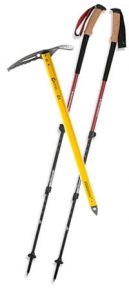 There is a time and a place for both an ice axe and trekking poles in the White Mountain National Forest. That said, if ever there were a default tool to rely on, surely trekking poles would earn that distinction. The ice axe’s role in the Northeast, in general, is pretty limited. In fact, with very few exceptions, a hiker wouldn’t even consider carrying an ice axe on most trips in the Whites.
There is a time and a place for both an ice axe and trekking poles in the White Mountain National Forest. That said, if ever there were a default tool to rely on, surely trekking poles would earn that distinction. The ice axe’s role in the Northeast, in general, is pretty limited. In fact, with very few exceptions, a hiker wouldn’t even consider carrying an ice axe on most trips in the Whites.
So when would it make sense to bring/use an ice axe? The answer is a simple one: you should first know how to use it, then carry then use it to carry out self arrest actions if you fall in areas and under conditions where long, sliding falls are possible but you’re not walking on actual ice — because an ice axe isn’t really meant to be used on ice, despite the name. This might include the summit cone of a few of the Presidentials (on some days), mountaineering in any of the gullies or slides, the “winter route” of the Lion Head Trail, the “North Slide” section of the Mt Tripyramid Trail, and a handful of other sites that share the characteristics of those listed.
Generally speaking, this doesn’t include in-the-woods sections, even though sliding down an embankment into trees or a stream is certainly possible. Trekking poles, which are helpful for staying on your feet to begin with, are a preferred choice in such places. If conditions are that bad, it is sometimes wise to use both: an ice axe in your uphill hand, and a trekking pole in your downhill hand. Another alternative to this would be to use a “whippet” — which is a trekking pole with a miniature ice axe pick attached to the top of the handle (common among alpine backcountry skiers, mostly).
The Axe is Good For…
Besides protecting from long, sliding falls, what else is the ice axe good for in the White Mountains? Well, they look cool. But then again, since they often aren’t even needed, the cool factor goes right out the window. How about using it as a cane? Resting your palm on the adze (while holding the axe in the “self-belay” position) can be comfortable, but only in really steep terrain. On typical White Mountain’s trails an axe of the prescribed length — which hangs from hand to ankle — causes one to stoop. The only other thing we can think it might be useful for is as a climbing- and/or down-climbing aid using it in the high- and low-dagger positions (with crampons employed), but that, too, is limited.
The Poles are Good For…
So what about trekking poles? Besides keeping a hiker on their feet by offering reliable and continuous handholds and helping the hiker stay balanced (so helpful on gusty days), what else can they do for you? If that isn’t enough already, poles are often credited for “saving the knees” and there is something to that. Using poles to aid stepping down can be relieving. Poles can also be useful for making a quick shelter, splinting a fracture (first aid), even trying to maintain distance between yourself and a fearful dog with an untrained owner, or other animal.
And The Verdict is…
So, should you use trekking poles or an ice axe? We suggest asking pointed questions of yourself regarding the terrain, conditions, winds, and any other of the potentially contributing factors, then, using your head, select the best tool for the job at that time. We’d advise against using the ice axe based solely on its coolness. As mentioned, if you didn’t actually need an ice axe, not only is your summit photo contrived, you didn’t serve yourself as well as you should have by arming yourself with the best tools possible. Moreover, you may have disadvantaged yourself if using poles would have been helpful, as they often are.
